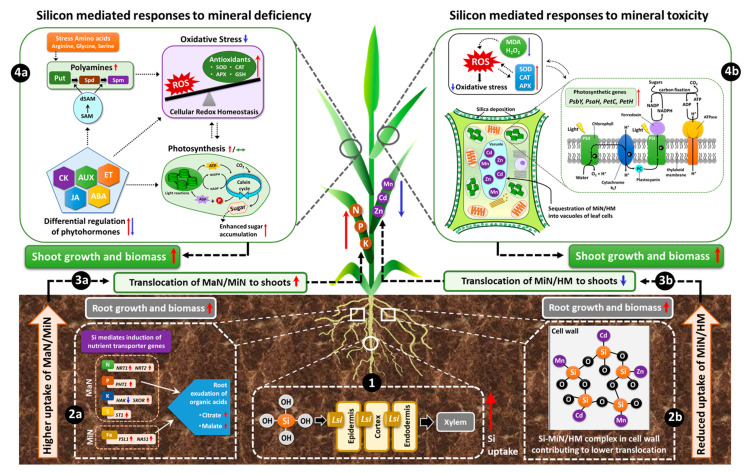Figure 2.
Schematic model displaying Si-mediated shared responses to nutritional stresses. The initial response to Si under nutritional stress is the uptake of supplied Si, mediated by induction of respective Lsi transporters in the roots (1). Consequently, under nutrient deficiency, Si induces the genes encoding the uptake and translocation of MaN/MiN in roots and facilitates increased uptake of the corresponding nutrient. For elements like P or Fe, root exudation of organic acids can lead to enhanced uptake of these nutrients (2a). Si-mediated higher uptake of nutrients further improves growth, biomass and related physiological parameters in the roots and results in increased translocation of MaN/MiN to the shoots (3a). In shoots, Si interacts with phytohormones, amino acids, metabolites and differentially regulates their synthesis both at the transcriptional and metabolic levels and thereby lowers oxidative stress by further modulating the antioxidant enzymes (4a). The simultaneous regulation of phytohormones/metabolites maintains or even induces higher photosynthetic efficiency resulting in enhanced sugar accumulation and eventual augmentation of plant growth and development and related physiological parameters (4a). On the other hand, for mineral/metal toxicity, Si employs a protective role by forming a complex with MiN/HM in the root cell wall (2b) and therefore contributes to reduced uptake and translocation of MiN/HM to the shoots (3b). In shoots, Si accumulation further mitigates metal toxicity by sequestration of MiN/HM into the vacuoles of leaf cells and simultaneously Si accumulation in the leaves improves photosynthetic efficiency by inducing the expression of photosynthesis-related genes (4b). In addition, Si reduces lipid peroxidation by lowering MDA and H2O2 levels and further increases the activity of antioxidant enzymes, which restores the redox balance, thus decreasing oxidative stress and consequently promoting plant growth and biomass (4b). Overall, Si has the potential of enabling the plant to react adaptively against nutritional stress responses and promotes tolerance. (Red arrows = increase/upregulation, blue arrows = decrease/down-regulation, dashed black arrows = hypothesised/proposed regulation, green double-headed arrow = maintained/preserved).

